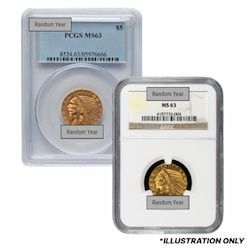$5 Indian Head Half Eagle Gold Coin
The $5 Indian Head Gold Coin is a distinguished piece of American coinage, highly sought after by collectors and investors alike. This gold coin, with a face value of $5, represents an era when gold coins were a significant part of the everyday monetary system in the United States.
History and Design
The Half Eagle $5 Dollar Indian Head Gold Coin was minted from 1908 to 1929. The Indian motif was designed by Bela Lyon Pratt, a student of the renowned sculptor Augustus Saint-Gaudens.
Pratt's design was commissioned by President Theodore Roosevelt as part of his ambitious project to revitalize U.S. coinage. The unique incuse design of the $5 Indian Head Half Eagle was revolutionary for its time, featuring a recessed, or sunken relief design with no raised edge, one of the only United States coins to feature that type of work until today.
The obverse of the coin features a portrait of a Native American chief, a departure from the usual depiction of Liberty. This design, known as the Indian Head, reflects both the spirit and the diverse cultural heritage of America. Surrounding the portrait are 13 stars, representing the original thirteen colonies, with the word "LIBERTY" inscribed above and the date below.
On the reverse, the coin displays a standing bald eagle clutching arrows and an olive branch, symbolizing the nation's readiness for both war and peace. The inscriptions "UNITED STATES OF AMERICA," the denomination "FIVE DOLLARS," and the motto "IN GOD WE TRUST" encircle the eagle. Unlike its $10 counterpart, the motto was included on the $5 Indian Head Half Eagle from its inception.
Mint Marks
The $5 Indian Head Half Eagle was minted at several U.S. Mint facilities, including the Philadelphia Mint (no mint mark), Denver Mint (D), San Francisco Mint (S), and New Orleans Mint (O). Each of these branches contributed to the production of the coin during different periods, with the New Orleans Mint only striking the coin in 1909, making those coins particularly rare. Coins from the San Francisco Mint are also highly prized, especially for their lower mintages in certain years. These various mint marks add another layer of collectibility, with coins from specific mints and years being more sought after by collectors.
Collectibility and Value
Condition: The value of the $5 Indian Head Half Eagle is significantly influenced by its condition and grading. Coins in higher grades, particularly those in Mint State (MS60 to MS70), are especially prized for their well-preserved details and original luster and will attract more substantial premiums.
Investment: Composed of .900 fine gold and .100 copper, the $5 Indian Head Half Eagle is not only a piece of history but also an attractive investment with a significant intrinsic value. Its bullion value is closely linked to the price of gold, making it a stable and appreciating asset for investors looking to diversify their portfolios with historical gold coins.
Rarity: Some dates and mint marks are particularly scarce and can command a significant premium. Coins minted in New Orleans and certain years from the Denver and San Francisco Mints are especially rare, making them highly desirable among collectors. The 1929 issue, minted during the onset of the Great Depression, is one of the most sought-after due to its low mintage and the economic context of the time.
Legacy
The $5 Indian Head Half Eagle Gold Coin stands as a testament to American ingenuity and the artistic vision of Bela Lyon Pratt. Its unique incuse design was a bold departure from traditional coinage, and despite initial skepticism, it has become one of the most cherished designs in U.S. numismatic history.
Collectors and investors alike value the $5 Indian Head Half Eagle not only for its gold content but also for its historical significance and innovative design. Its legacy as a symbol of American creativity and resilience endures, making it a must-have for those passionate about gold coins and American history.

















